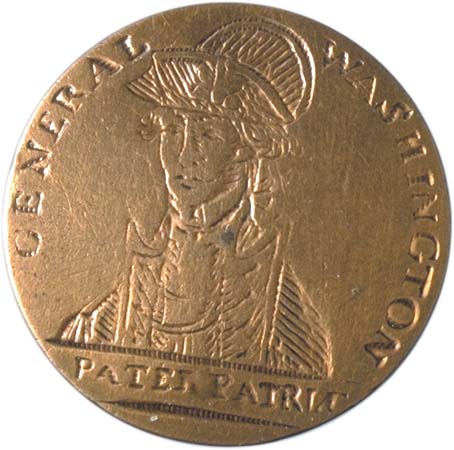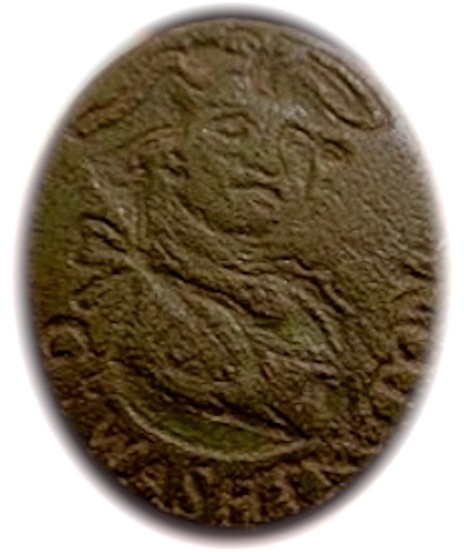GWI 19-A, B, & C PATER PATRIAE: In my opinion, the Pater Patriae is a German Made American Revolutionary War Tribute button to celebrate General Washington as the esteemed Father of our Country circa 1779-1784. This would be the 1st American Tribute relic known to exist. After having the privilege of obtaining one for myself, and holding the button in my hand for a detailed examination, i can say for certainty the German Artisans in America really made a high quality master pieces! The button depicts a portrait style military bust of George Washington while he was commissioned as General of America’s Continental Army. Robert L. Milburn discovered the Pater Patriae’s design was taken from a popular book plate image of General Washington, which was the works of Engraver-Artist Robert Pollard in 1778.
The button depicts George Washington facing left, wearing a Cocked Hat (Tricorn Hat) adorned with a Five Petal Jacobite Rose. The significance of the rose was most likely an era tribute to the Scot-American gentry (Prince Edward Stuart wore a 5 petal rose to war); who remained in generational resistance to the English Parliament and the Hanoverian King George III. Flanking both sides of Washington’s portrait is the inscription, “General Washington.” Inscribed in the lower legend is the German-Latin honorific inscription, “Pater Patriae” which means father of the fatherland. Around Washington’s neck is a military Gorget which is worn both as a badge of rank, and an indication they “were currently on duty.”
The gorget with other variables might be circumstantial evidence to dating the conception of the Pater Patria button to before the war’s end in 1779 to1784. We know that Alexander Campbell’s portrait sitting was in 1778, for the book, and he specifically dressed in military wardrobe, and specifically posed for a reflection of military class status and deportment. To help capture the here and now or “in the time of commencement,” as events unfolding in real time, we believe the sitting and the engraved plates was to reflect General Washington in current active duty; as the book was written and published during war time.
George Washington knew that state newspapers and publications here in America and in London were feeding the frenzy for war time news. Many of these publications were running likeliness of him, and for better publications a sitter was used to place a high quality likeness next to the article. There are two portraits of Washington attributed to Alexander Campbell of Williamsburg, VA, and all printed by C. Shephard of London. George Washington was said to have been favorable to Alexander Campbells sittings for his portrayal. George Washington comments on mister “Campbell” from his own words in the letter of 31st, January 1776, in which he thanked colonel Reed, his secretary for the gift of the (Alex Campbell) engraving. (A Fan of Campbell, why not)? Portraits of all revolutionary war figures were popular to feed the frenzy of the publics thirst for war time events and battles. Sitters were used for British Generals as well.
There are three known Pater Patria buttons which could date as early as 1778/9, but i believe the Patter Patriae to be a Revolutionary War Hero Tribute button at the wars close in 1783/4. I distinguish them as, GWI 19-A, B, and C. GWI 19 A & B are inaugural buttons, but GWI 19-C & D are just of 18th century era. GWI 19-D appears to be a matching cuff to GWI 19-C.

20th Century Old School of Thought & Facts
GWI 19 A & B are the commonly known Pater Patriae buttons which have been thought by the button collecting community to be sold during the celebratory time periods of George Washington’s 1st and 2nd administrations 1789-1797. GWI 19-C cannot be confirmed as an inaugural button, but does date to the Federal Period in both metal and construction. This oval shape button is crudely engraved and lacks the precision quality of German Artistry. This was unearthed in New York during the early 1990’s.
GWI 19 A & B share the same copper shell design on the obverse, but have different construction designs for the reverse. GWI 19-A has a copper shell obverse and is found with a different variety of metal alloys for the back fill and an iron wire loop shank. GWI 19-B’s construction is unique in nature and a tribute to an earlier period of officer / gentry buttons which was more expensive to fabricate. This is a Silvered Copper shell with a four sew hole bone back with cat gut cord. The specimen with bone back with cat gut cord reverse is considered unique. GWI 19-A & B are 25mm. in size.
GWI 19-C unusual oval shape was probably fabricated with the intent of military tribute of sorts using a breast or shoulder plate military design. GWI 19-C’s depicts George Washington as younger military officer wearing a British Gorget around his neck. This could lead to a collector hypothesis that this was a French Indian War tribute to George Washington when he served as a commissioned Major of the British Province of Virginia. This would account for his younger military bust and British Gorget around his neck and British style shoulder plate oval design. GWI 19-C approximately measures 20mm x 12mm. The reverse shank on GWI 19-C is also reportedly and integral part of the cast instead of a soldered on loop shank.
GWI 19-D a small portrait cuff button, but the exact dimensions are unknown to us at this time. This is the only George Washington inaugural era cuff button known to feature a portrait of George Washington.
I can only confirm 10 known specimens as of 2018. Auctions sales in contemporary times has only come around 4 times. I guess it would be proper to list them from the earliest known owners or sellers, and place the current owners under each of the known specimen’s pictures.
1) Albert’s Plate Specimen. 2) J. Harold Cobb Specimen from Ruby Darrohn. 3) The Ruby Darrohn had a second that went to a family member at an equitable price. 4) Piercy’s Specimen purchased through Eastern Coin auction. 5) Mt. Vernon’s Specimen (Bent & Cracked) sold in Virginia at auction from a Virginia Estate. 6) Rex Stark sold a Specimen at fixed price. 7) Brook M. purchased the Heritage Auction Specimen in 2015 8) David & Janice Frent 9) A.C. Needham of Massachusetts Silver over copper Specimen with 4 hole Bone Back and cat gut cord to sew into garment. 10) Reba G. Smith of Massachusetts Copper (Most Likely Orig. Silvered) Specimen with Pewter Back and Iron shank.
Specimen’s Unverified: Mr. Robert Arnell of Long Island, N.Y. supposedly had a Silvered Copper face with a four sew hole Bone Back and Cat gut cord. this specimen is subject to question, and its present location is unknown. Could this be Flud’s unique example?
-Thomas Owens of Gorham, Maine acquired a specimen that is somewhat worn, from a woman in his home town.~
-The Netherland’s Sale Lot#1086 which went to Cobb’s friend Piercy. Did he own 2 specimens?
The Pater Patriae name was first given to the Roman God, Jupiter
*
************* ************* ************* *************
************* GWI 19 A & B *************
****************

GWI 19-B THE PATER PATRIAE
Color: A Deep Reddish Brown with Golden Highlights.
Metal: 3-Piece, Impressed Design, Silvered Copper Shell.
Size: 25mm. 85.4 Grains.
Rarity: R-5
Variety Type: GWI 19-B Copper Shell Led Filled Back
Present Condition: A Non Dug Specimen, A Strong Planchet Condition, A Strong Impression Remains.
Obverse Button Analysis: This is an extraordinary specimen that retained most of it’s original pattern. The brass shell appears to be solid, but it does show some metal loss with a small notch above the “W” in WASHINGTON. Fortunately, it doesn’t reach in far enough to effect the image of the Cocked Hat or “W”. As with all of Cobb’s buttons, this has been lightly cleaned by him, but it still retains a nice tone. The surface shows some light scratching and wear. The brass is also tarnished in the field around the word, “GENERAL” the Side of the hat, and by the “NG” in his name. The inner details of the facial features don’t show a strong image, but there is still a good outline for the facial features. His military uniform is the strong point of this button’s pattern. The lines show a deep impression and a clear image. There is a spot of flat wear in the middle of the bust, but fortunately all the surrounding lines fill out the whole picture. The Cocked Hat has a strong strike and a clear image. Unfortunately, in this specimen, the wig underneath the hat is practically undetectable. The military cockade on the hat is barely noticeable, and only shows a light foot print. The Roman Font capital letters for Washington’s military title, “GENERAL WASHINGTON” appears to be another strong asset of the button. The letters show a nice deep strike, along with good letter lines. The horizontal lines above and below the bottom catchphrase, “PATER PATRIAE”, have nice wide line strikes, and still retain their inner definition lines. The catchphrase, PATER PATRIAE is only half readable. The “PATRIAE” is barely readable. As with all examples of this variety, there is an uneven thickness and symmetry in the lines and letters used in the catchphrase. This is the result of the original manufacture’s die not being measured properly for the die.
Reverse Button Analysis: This button has a pewter backing with an Iron Loop Shank. Medium Gray/Silver Color. Cobb Label on Back.
Library Records Has Limited Information WI 19 B-5:
History: Yes Recorded Sales Price: Yes
Current Button Owner and Location: Williamsburg VA.
Ruby Darrohn’s Family Heirloom.
Harold Cobb/Descendants 1957.
sold in Stacks Auction
Lasser Family.
Gifted from Lasser to Colonial Williamsburg, VA
Cobb obtained his specimen in 1957 from Ruby Darrohn of New York. Her family was fortunate enough to own *Two as family heirlooms. His first attempt at acquiring one failed, when it was sold to a family friend. His second try was successful, working through an antique dealer who swapped furniture for the button. It ended up working out better for Cobb, because the piece he got was described by the owner as “…a better one than the first one, as the lettering is much plainer…I did not clean it at all”.~
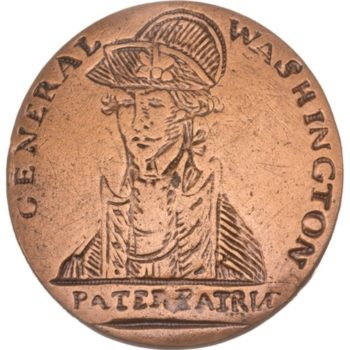
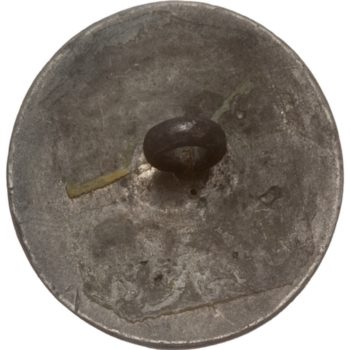
GWI 19-A THE PATER PATRIAE
Color: Brass Yellow.
Metal: 2-Piece, Impressed Design, Copper Shell, Pewter Back, Iron Shank.
Size: 25mm. 86.1 Grains
Rarity: R-5
Variety Type: GWI 19-A Copper Shell With metal filled back W/ Silver Wash?
Present Condition: A Non Dug Specimen, Strong Planchet Condition Remains, A Strong Impression Remains.
Obverse Button Analysis: This button has been lightly cleaned in the past, but has started to re-tone nicely. The copper planchet is solid and flat, and shows no very little blemish to the surface metal. There are a few light scratches to the surface, but nothing harsh that detracts from the GW’s portrait image. The Cocked Hat, and the wig underneath still displays a strong image, with all the inner details lines. The Cockade on the front of the Hat has a strong outline with a good image also . The Roman Font capital letters for Washington’s military title has a nice deep strike, and the letters are easy too read. All the inner definition lines within the letters are still present, except for the “A” in WASHINGTON. The horizontal lines above and below the bottom legend (PATER PATRIAE) have a nice deep strike, and show the inner horizontal definition lines clearly. As with all the known examples, there appears to be an uneven thickness and symmetry in the thickness and cut of the lines. This probably is the result of the die not being properly cut due to a poor measurement consideration for the button’s diameter. The bottom Catchphrase, “PATER PATRIAE” still shows a nice deep strike, except for the “R” in PATER, and the “P” in PATRIAE. Aside from the poor die measurement for the bottom Catchphrase, this button is an excellent example for this rare variety.
Reverse Button Analysis: Medium Gray Color. This button has a soldered on Iron loop shank. The shank is original, straight, and intact.
Library Records Has Limited Information WI 19 B-1:
History: No Recorded Sales Price: Yes
Current Button Owner and Location: Colorado
The Brook Mahoney Collection in 2018
Previously the Frent Collection.


GWI 19-B THE PATER PATRIAE
Color: Antique Copper.
Metal: 2-Piece, Impressed Design, Copper Shell, Filled Led Back.
Size: 25mm.
Rarity: R-5
Variety Type: GWI 19-A Copper Shell W/ Metal Fill Back W/ Silver Wash?
Present Condition: A Dug Specimen, A Good Planchet Condition, A Good Impression Remains.
Obverse Button Analysis: As close to “natural state” as could be expected. An enjoyment to hold in hand, and marvel at the German American Artistry. As a long time collector i appreciated the quality of the construction and got a true feeling of the era.
Reverse Button Analysis: This button has a loop shank.The shank is original, straight, and intact.
Library Records Has Limited Information WI 19 B-2:
History: Yes Recorded Sales Price: Yes
Current Button Owner and Location: New York
The Robert J. Silverstein’s Isabela Collection in 2018
The B. M. Collection, 2015.
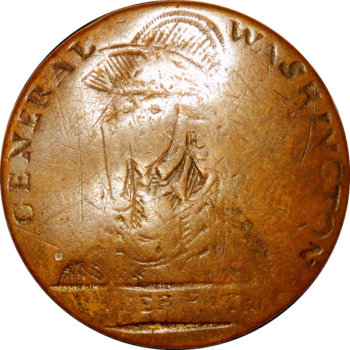

GWI 19-A THE PATER PATRIAE
Color: A Soft Coppery Brown.
Metal: 2-Piece, Impressed Design, Silvered Copper Shell.
Size: 25mm.
Rarity: R-5
Variety Type: GWI 19-A Copper Shell With Pewter Fill Back.
Present Condition: A Non Dug Specimen, A Good Planchet Condition, A Fair Impression Remains.
Obverse Button Analysis:
Reverse Button Analysis: This button has a loop shank, Pewter or Tinned back or Silvered Iron Shank.
Library Records Has Limited Information WI 19 B-3:
History: Yes Recorded Sales Price: Yes
Current Button Owner and Location: Yes
The Roger S. Collection in 2018
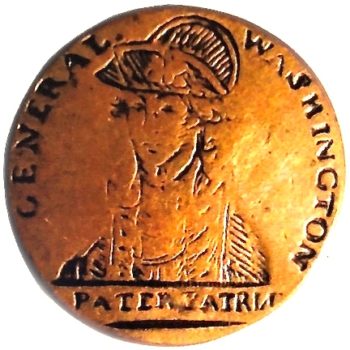
GWI 19-A THE PATER PATRIAE
Color: A Soft Coppery Brown.
Metal: 2-Piece, Impressed Design, Silvered Copper Shell.
Size: 25mm.
Rarity: R-5
Variety Type: GWI 19-A Copper Shell Metal Filled Back
Present Condition: A Non Dug Specimen, A Good Planchet Condition, A Fair Impression Remains.
Obverse Button Analysis:
Reverse Button Analysis: This button has a loop shank, Pewter or Tinned back or Silvered Iron Shank.
Library Records Has Limited Information WI 19 B-4:
History: No Recorded Sales Price: No
Current Button Owner and Location: Yes
The R. U. Collection in 2018

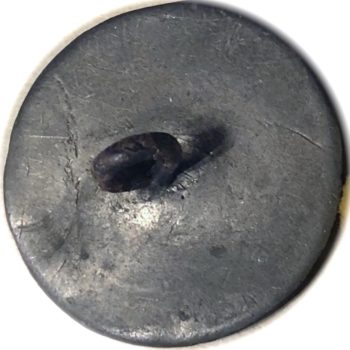
GWI 19-A THE PATER PATRIAE
Color: A Rich Coppery Brown.
Metal: 2-Piece, Impressed Design, Silvered Copper Shell.
Size: 25mm.
Rarity: R-5
Variety Type: GWI 19-B Copper Shell Metal Fill Back W/ Silver Wash?
Present Condition: A Dug Specimen, A Poor Planchet Condition, A Good Impression Remains.
Obverse Button Analysis:
Reverse Button Analysis: This button has an Alpha loop shank.
Library Records Has Limited Information WI 19 B-7:
History: Yes Recorded Sales Price: Yes
Current Button Owner and Location: No

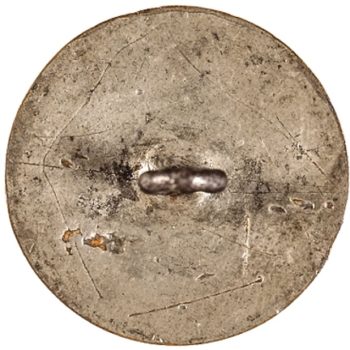
GWI 19-B THE PATER PATRIAE
Color: A Polished Coppery Brown.
Metal: 2-Piece, Impressed Design, Silvered Copper Shell.
Size: 25mm.
Rarity: R-5
Variety Type: GWI 19-B Copper Shell Pewter Back W/ Silver Wash?
Present Condition: A Dug Specimen, A Poor Planchet Condition, A Poor Impression Remains.
Obverse Button Analysis:
Reverse Button Analysis: This button has a loop shank.
Library Records Has Limited Information WI 19 B-7:
History: Yes Recorded Sales Price: Yes
Current Button Owner and Location:
Picture Courtesy of Dane L. of E.A.A.


GWI 19 THE PATER PATRIAE: 18th Century Anniversary Possibility
Color: A Light Polished Brass Yellow with Verdigris spots.
Metal: Convex, 1-Piece, Tombac Style Reverse W/ Impressed Design, Gilt Brass.
Size: 25mm.
Rarity: R-5
Variety Type: GWI 19, Brass Sub Variety.
Present Condition: A Non Dug Specimen, A Good Planchet Condition Remains, A Strong Impression Remains.
Obverse Button Analysis: This recent example surfaced in an 2005, and it’s provenance was established to be from an old Virginia family that had passed it down as a family heirloom over the centuries. I believe as with the other Mt. Vernon Specimens that this was made as an Anniversary or struck later for an American celebration. This construction mirrors reverse British military tombac reverse construction buttons.
Unlike the others examples of this variety, this planchet has a slightly convex obverse, not flat as all other Pater Patriae’s of the 1780’s. The brass planchet is solid, but shows some metal loss with a chip in the middle. The surface color has some kind of chemical discoloration from using improper cleaning solvents. Somehow the metal’s color oxidized and turned a greenish-yellow throughout the whole surface. As for the planchet, there are a few light scratches and abrasions to the surface, but they seem to have blended in nicely over time with the button’s patina. Washington’s facial features and military coat is unfortunately worn flat, and lacks a clear detailed image. His cocked hat has a poor impression, and shows a lot of flat wear. The military cockade on the front of the hat is worn smooth into the surface. The Roman Font capital letters for “GENERAL WASHINGTON” only retains a light foot print impression, but the letters are still easy to see and read for the most part. The inner letter lines are completely absent. The horizontal lines above and below, “PATER PATRIAE”, still have a nice impression, and retain a clear image of the inner definition horizontal lines. The bottom catchphrase, “PATER PATRIAE” still has a nice deep strike, except for the end, “RIAE” in PATRIAE. Unfortunately the word, PATER PATRIAE wasn’t specially cut within the die to fit the planchets diameter properly. This seems to be the case for this variety. Obviously this button wasn’t copied by different Artisans, or this mistake would have been corrected and shown in other examples. I do not see this button ever coming back to the market for GW collectors. On the good side, it will be seen by thousands of visitors a year to George Washington’s home in MT. Vernon.
Reverse Button Analysis: This button is slightly concave, and has a Tomback Style loop shank soldered on top of a raised dome. The surface is smooth, and free of any harsh scratches and abrasions.
Library Records Has Limited Information WI 19 B-6:
History: Partial Recorded Sales Price: No
Current Button Owner and Location: ~ Virginia ~
George Washington’s Home at Mt Vernon, Virginia.~
Added to Mount Vernon Estate, Museum & Gardens.~
Other Possible Examples of GWI 19:
Mr. Robert Arnell of Long Island, New York supposedly had a Copper face with a bone back and catgut shank, this specimen is subject to question, and its present location is unknown.~
The only one known of this construction was described as having a Silvered Copper face.~
Thomas Owens of Gorham, Maine acquired a specimen that is somewhat worn, from a woman in his home town.~
One example is know to have Bone Back, Cat Gut Shank.~ ex. Flud~
Accounting for the original examples known in the 20th Century: Ruby Darrohn (2), Piercy (1), Flud (1), Albert (1), and the Smithsonian (1).
*************
************* GWI 19 C & D *************

GWI 19-C 1790-1800 WASHINGTON SOLDIER ANNIVERSARY CUFF LINK
************* *************
The GW sleeve link is 18th Century drilled integral shank, which makes it earlier than the brazed, the English would not have made it prior to the Paris Treaty, so i believe this was an Anniversary Issue of the American War of Independence Circa. 1790-1800. Meaning, he was probably alive when these were made.
GWI 19-C 1790-1800 WASHINGTON SOLDIER ANNIVERSARY CUFF LINK
Color: A Nicely Aged Greenish Brown Patina
Metal: Flat, 1-Piece Impressed Design, Brass.
Size: Oval Shape, 20mm x 12mm.
Rarity: R-7
Variety Type: A Younger Washington / Fluid Style.
Present Condition: A Dug Specimen, A Good Planchet Condition Remains, A Good Impression Remains.
Obverse Button Analysis: Top Kudos for the metal detector hobbyist that discovered this rare beauty. This style button was thought to be lost to time until a few years ago. The brass planchet is solid and flat, and shows no metal fatigue, loss, or deterioration. The button luckily has no deep scratches or abrasions, but it does have microporosity spread evenly throughout surface. The portrait of Washington still retains a nice deep impression, and shows good fluid lines for his facial features and garments. The tricorn hat upon the young Washington’s head also shows a good image, with clean fluid lines.There is a Wig underneath his hat, but is hard to see. The military gorget with the ribbon and bow still has an outline impression, but not really a clear image of it’s design. At the bottom of the button is Washington’s first initial “G.” and last name, “WASHINGTON”. These letters are all in Roman Style capital block letters. Unfortunately, most of the letters are decayed and worn flat into the surface. The letter lines lack clear edges, and the “INGT” in WASHINGTON is just unreadable. Overall this is a wonderful new discovery with a great fluid design. This is a real welcome into this variety.
Reverse Button Analysis: This might possibly be a One-Piece Casting for the Reverse Shank. (The Shank is also an integral part of the button itself). Shank is reportedly original, straight, and intact.
Library Records Has Limited Information WI 19 C-1:
History: Yes Recorded Sales Price: Yes
Current Button Owner and Location: No
This was recently discovered in the 1990’s, by the use of a metal detector.~


GWI 19-C 1790-1800 WASHINGTON SOLDIER ANNIVERSARY CUFF LINK
Color: A Golden Brown.
Metal: Slightly Domed, 1-Piece, Impressed Design, Stamped Brass.
Size: Oval Shape Cuff Link Size.
Rarity: R-6
Variety Type: Younger Washington / Fluid Style.
Present Condition: A Dug Specimen, A Good Planchet Condition, A Strong Impression Remains.
Obverse Button Analysis: This is an extraordinary example of a gentleman’s cuff link from the late 1790’s. The planchet is oval and slightly domed. This specimen is corroded from ground action, but fortunately shows no chipping or metal loss. The surface appears to be granular, and shows signs of micro porosity. The portrait still has a clear image and a good strike impression. The facial features and garments still show nice fluid lines. The tricorn hat still retains a deep strike outline, but there are a few spots smooth wear to the image. Underneath the tricorn hat he appears to be wearing a gentleman’s wig, which only retains a very light impression, but an image remnant is there. Lightly stamped around the young Washington’s neck is a military gorget tied with a ribbon and bow. The ribbon is not clearly defined, but the bow is still present and retains a good image. At the bottom of the button is Washington’s first initial, and last his name, “G. WASHINGTON”. This is in all Roman Font capital block letters. Unfortunately, most of the letter lines are decayed, or worn smooth into the surface. Overall this is a wonderful example, with a great design. This size is a real welcome into this variety.
Reverse Button Analysis: This is a flat one-piece button with a loop shank. Shank is Original and intact.
Library Records Has Limited Information WI 19 C-2:
History: Yes Recorded Sales Price: Yes
Current Button Owner and Location: No
This was Dug By Steve Evans on Site of John Proctor’s House
GWI 19-C 1790-1800 WASHINGTON SOLDIER ANNIVERSARY CUFF LINK
Color: An Ocher of Brown, Green and Yellow.
Metal: Flat, 1-Piece, Impressed Design, Brass.
Size: Oval Shape, Cuff Link Size.
Rarity: R-6
Variety Type: Younger Washington / Fluid Style.
Present Condition: A Dug Specimen, A Fair Planchet Condition Remains, A Good Impression Remains.
Obverse Button Analysis: This is another great example of this rare cuff link that still shows a clear image of the original pattern. The brass planchet shows fatigue and is corroded due to ground action. The surface has a nice even greenish brown color shade. Most likely this specimen was buried in or near ground water. The portrait still retains a nice deep strike impression, and has a good image of the facial features and garments. The tricorn hat has a nice outline with clear fluid lines. The gentleman’s wig underneath the tricorn hat is kind of lost in idenity. The military gorget tied around Washington’s neck still has a decent impression and image. The ribbon and bow holding the gorget also has a clear image. At the bottom of the button is Washington’s first initial, and last name, “G. WASHINGTON”. This is easily readable, but the letters are corroded and decayed. Since there isn’t to many examples of these cuff links, this example would probably be considered above average.
Reverse Button Analysis: This is a flat one piece button with a loop shank. Shank is Original and intact.
Library Records Has Limited Information WI 19 C-3:
History: Yes Recorded Sales Price: Yes
Current Button Owner and Location: No
This was Excavated in South Carolina.~
Mr. Robert Arnell of Long Island, New York supposedly had a Copper face with a bone back and catgut shank, this specimen is subject to question, and its present location is unknown.~ (This would be like Flud’s unique example.
-Thomas Owens of Gorham, Maine acquired a specimen that is somewhat worn, from a woman in his home town.~
-The Netherland’s Sale Lot#1086 which went to Cobb’s friend Piercy.
Construction Dating: Warren Tice
 ************* ************* ************* *************
************* ************* ************* *************
Winterthur Museum: Thomas Willing, President of the 1st US Bank and Member of Congress in Philadelphia.
These buttons dated to 1776, appear to have led or pewter filled interiors to hold the shank and face in a rim. These are attributed to the German-American Craftsman in Pennsylvania working in the last half of the 18th century.
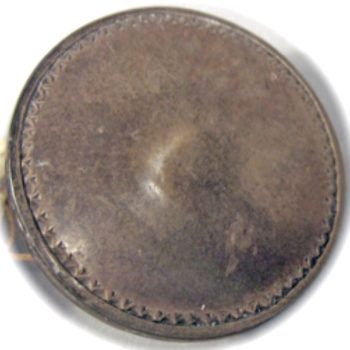
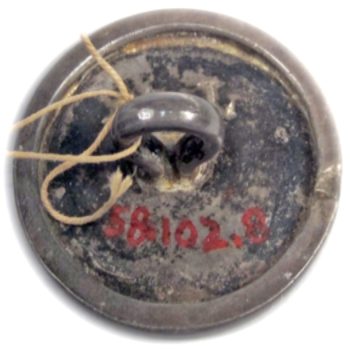
Examples of 18th Century Tombac German-American Construction buttons 1780’s as Pater Patriae.
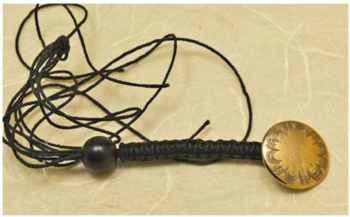

These buttons date to 1750’s. This kind of gives us a cross-match style of construction techniques for shell buttons and Tombac reverses. I found it interesting how these Colonial Tombac’s were filled as reinforcement to the alpha shank. I do agree it is unusual, but the point must be illustrated. Meaning, even though led fill is considered unusual for a Colonial Tombac, (some) button makers were doing led fill reinforcement on tombac reverses since at least the 1750’s.


German Specimens with Filled Led or Pewter Backs


Robert Milburn Collection


Robert Milburn Collection
General Washington Engraving Plate
************* Discovered by ************
Lt. Col. Robert L. Milburn
12-07-2018
*************
*
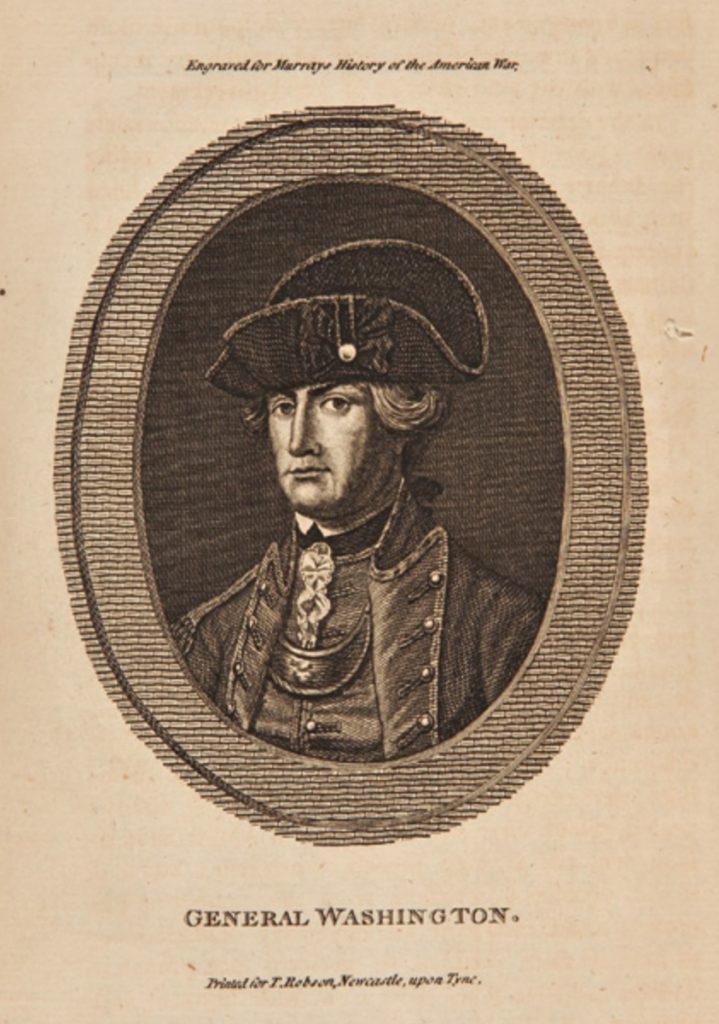
Engraver, Robert Pollard of New Castle, Tyne.
Picture Provided from R.J. Silverstein’s Library
*
Robert Pollard
Robert Pollard was an 18th Century English engraver and painter living in America during the American Revolution War era. He engraved a large number of plates in a specific signature style in which he used an intaglio print making technique, which is a variant of etching. He did line engraving prints of Revolutionary War time heroes to go with media articles demanded by the public. Pollard’s images were plate printed on laid paper to be used as, “commercial prints and illustrations” in magazines, books, and he even did reproductions of paintings for plate prints. He executed his own mixed style and produced his own designs in landscape and maritime.

Robert Milburn’s discovery of the engraving plate provided some key details of the era, and helped us perform a reasonable conclusion in dates. We believe the Pater Patria’s design could have used by German Artisans living in America as early as 1779, for the earliest engraved printing for T. Robinson. There is no factual sequence of events, but i believe there was a transition of thinking in society because people had sufficient time in understanding the war was drawing to a close for more than a few years, this might be an argument for the Pater Patria to have been made before war’s end in 1784. Other printed accounts geared for the Gentry class in the change of social contracts lead way to this line of reasoning as early as 1779.
The first printed plate impressions available to the public would have been from the book, “An Impartial History of the War in America, From its First Commencement to the Present Time,” in 1778. Unfortunately, there is no evidence to when the Bruce Campbell sitting of Washington design was selected and used to make the Pater Patria, but we can say the earliest release was in 1778. I do believe the original plate engraving of Alexander Campbell’s sitting could have easily been accessed by German Artisans of the time, or relatively simple for them to get an original plate print from the book. We are uncertain if the second edition release in 1782, had used the same original plates, or if Robert Pollard engraved replacement plates before he left for London, England in 1781; to continue his work as an engraver and print seller. By 1788, Pollards engravings elevated his work and earned him directorship position of the “Incorporated Society of Artists.”
************ ************ *************
The Engraving Plate Cross-Matching Comparison Points
&
Facial Recognition Overlay
************ ************
*
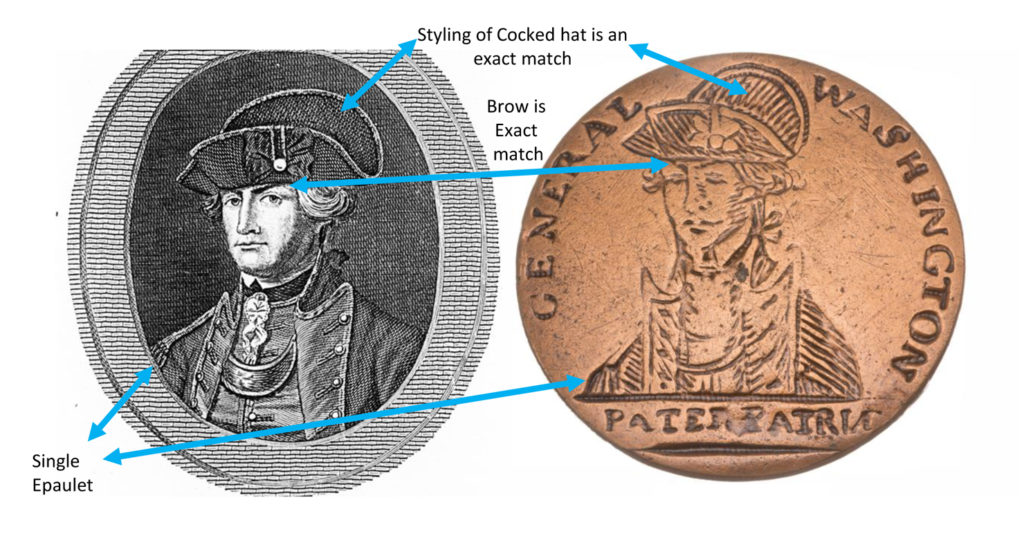
************* ************ ************
************ ************
*
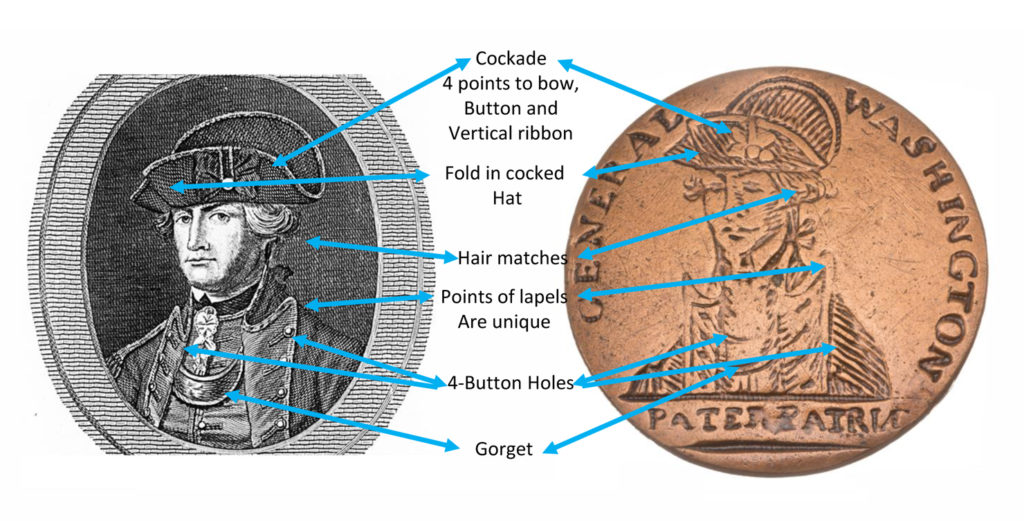 *
*
************* ************ ************
Robert Pollard’s Engraving overlay
matches in facial recognition software perfectly
************ ************
*
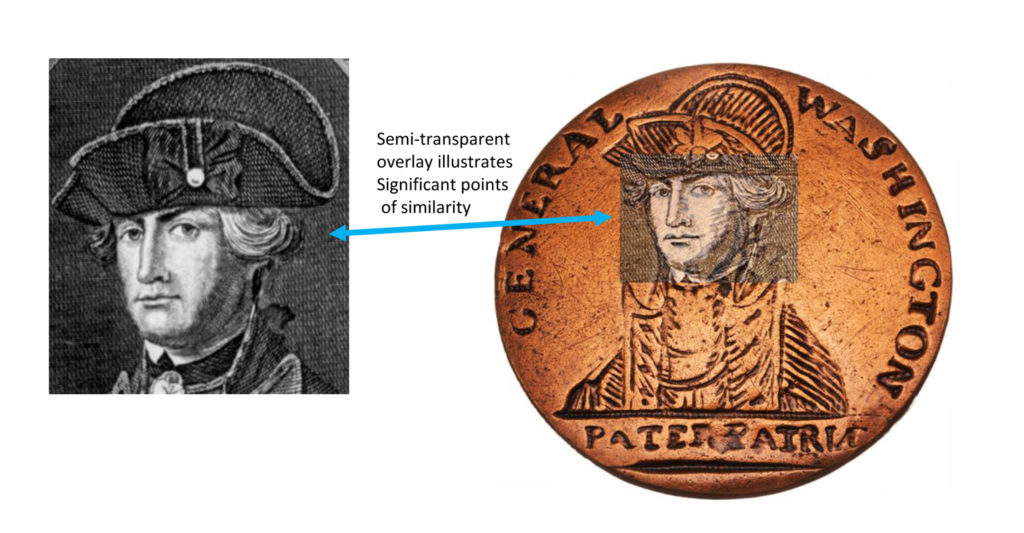
*
The Engraving Plate Matching Comparison Points
1) General Washington is wearing a Cocked Hat.
2) There is a Cockade on the hat with four points to the ribbon, with a button in the center.
3) The fold in the hat is an exact match.
4) The hair style, and eyebrow arches match.
5) The lapels are very sharply pointed, and there are four buttonholes depicted upon each lapel.
6) He is depicted wearing a Gorget, this is a crescent shape metal badge which hangs round the neck. Gorgets are usually Silver and denotes the officer is an officer of rank in “Active Service.”
7) The peculiar styling of the cocked hat is almost as unique a signature as the fingerprint.
8) A single epaulet on the left hand side is shown in the depiction on the button.
9) The lip line is in a “Pout.” The jaw line is a unique points of reference for comparison.
Upon our review of more than 400 engravings, mezzotints and other images of George Washington, there appeared to be similarities in the work of Alexander Campbell sitting.
The work referencing an artist named Alexander Campbell, of Williamsburg, VA, date to 1775, they bear the most similarities to the portrait of General Washington used on the Pater Patria Buttons. There are two portraits of Washington attributed to Alexander Campbell all printed by C. Shephard of London. The works printed by shepherd do not claim to have been engraved or executed by Alexander Campbell, but carry the statement that its image was “Drawn from the life, by Alexander Campbell of Williamsburg, Virginia.”
*
************* ************ ************
************ ************

The earliest published engraving depicting the announcement of George Washington as, “Father of our Country” in 1779.
This was in the Pennsylvania German Language 1779, Rittenhouse Almanac.
************* ************* *************
The Pater Patriae is a high-end German-made tribute button which could date as early as 1778/79. This is a military style portrait of General Washington with the inscription, “Pater Patriae” in the lower legend. The construction techniques used to create these buttons are those consistent with button manufacturing techniques during the Revolutionary War period and shortly thereafter; particularly the specimen which has a capped or faced metal front, with a bone back and catgut shank, the cap or face of the button is filled with a pitch-based cement or mastic which holds the back in place and helps to prevent denting of the front cap. The other known Pater Patriae buttons are copper shells, filled with lead or a lead-based pewter, and half-round hand drawn wire shanks.
The only way to improve the estimated date of manufacture of an 18th century button, particularly a Portrait button is to establish the earliest time the pattern of the button could have been designed. So, in order to firm up the date of manufacture of the Pater Patriae Buttons, the best way would be to discover if there was an actual pattern or model employed for the design of the buttons and the likeness used of “General Washington”.
Facts
*
1779 – Was the 1st time a Portrait of General Washington was used by a German Language Almanac referring him as the Father of our Country. This was compiled by David Rittenhouse…… General George Washington was named “Father of His Country”
1780 – The Engraving Plate of General Washington (using Alexander Campbell as a sitter) by Robert Pollard was ultimately chosen to be used for German-American Made Pater Patria buttons.
************* ************* *************
- Located in the Library of Congress Important & Rare Prints Catalog. Baker No. 56.
- This is one of those types of works that is classified as, “Living prints or portraits” which were executed during George Washington’s lifetime.
- Original Plate Printed Copies on laid paper are extremely rare and a scarce number is known to be in Private collections.
- According to the Philadelphia Print Shop, it is considered an, “Extreme Rarity” to have a lifetime portrait or print of General George Washington from the Revolutionary War era.
- We also, know that 18thCentury Plate Prints on laid paper is extremely scarce in the collector art market of Revolutionary War figures, and unfortunately, only 10% of Washingtonian era literature remains in public institutions, and less then 4% in private collections.
- George Washington’s comments on mister “Campbell” from his own words in the letter of 31st, January 1776, in which he thanked colonel Reed, his secretary for the gift of the (Alex Campbell) engraving). This exceptional plate engraving is found in Murray’s 1st edition in 1778-80, “An Impartial history of the War in America, from its First Commencement, to its Present Time (1778).
- 18th Century plate prints of George Washington on laid paper are weighted by the “relative condition and rarity.” We believe there will be an increase in value to any known original copies of Bruce Campbell portrait sitting of George Washington due to it’s recent match to the Pater Patriae button design.
- An impartial History of the War in America, from its First Commencement, To the Present Time. 1778-1780 1st Murry, James. The 1778/79 first editions would have the Best and clearest Pater Patriae plate print for German Artisans to reproduce an easy recognizable(by people living in the era) portrait for the engraving of a Revolutionary War Tribute button.
- We do not know how many books were printed in the 1778 for original release; and the Pater Patria could have been made as early as 1778 to 1780 timeframe.
- The Library of Congress has a plate print specimen of Washington taken from the 1stedition 1778 engraving. This is located in their special living works section. Meaning, good luck, they do not make prints of certain American works.
- In the Revolutionary War years it was customary for citizens to tear Plate prints out of books and hang them on their walls as an admiration of beloved founders.
- The Pater Patriae button was designed to commemorate General Washington as, Commander and Chief, of the Continental Army who was victorious over the British in the Revolutionary War.
- General Washington is depicted wearing a Cocked Hat with a 5 Petal Rose in the forefront. This could be seen as a Scottish tribute since this was known at the time as, a “Scots War” on both sides of the Atlantic Oceans news media.
- George Washington is portrayed in a Military Uniform with a shoulder epaulet on the right shoulder only, and military distinction of a Crescent-shaped gorget around his neck. The gorget is worn both as a badge of rank, and an indication they “were on duty.”
- The Pater Patriae button shows high-end German construction, which is similar to other high-end buttons, which were made for the gentry or military officers.
- European Masonic Social clubs of the 17thCentury ushered in the use among gentry too wear buttons as political and social statements of public interest.
- American freemasons in the 1770’s, were mostly newly landed gentry who were disgruntled by English Parliamentary Law and class stratification. The lodge members in America did carry-on European traditions of wearing artistic buttons to make social and political statements. They wore Rattlesnake buttons of various patterns for Revolutionary political statements. These symbols were naturally congruent of the printed media of the time.
Unfinished Draft below 12/18
Robert L. Milburn’s Notes
I first noticed the similarities to the Pater Patriae image, in the ¾ Military bust portrait of General Washington, in an “Anonymous (British, 18th century), after “Alexander Campbell”, George Washington, Esqr. General and Commander in Chief of the Continental Army in America, Mezzotint and line engraving, London: C. Shepherd, 1775, printed by C. Shephard London”. This had enough similarities to draw my attention but not enough to mark it as the image used, artists of the period routinely flipped head images horizontally to use on other anonymous engravings, when I flipped it the image points of reference increased, but again, not enough. So, with that in mind I searched for other image based upon the work of “Alexander Campbell”.
I found a close match in a Mezzotint of 1775, again, published by C. Shepherd, London, after Alexander Campbell. The mezzotint is an equestrian portrait with George Washington advancing to the left, holding a sword, a battle in the distance.
At this point I would like to tip my hat to one of the definitive catalogers of early Washington images, William Spohn Baker, he is the first, in modern times to identify the artist Alexander Campbell as a fictitious character or a Nom de Plume.
” src=”blob:http://www.georgewashingtoninauguralbuttons.com/7e1f89a5-275f-4a4f-96a9-cf9476ccf3dd” alt=”image002.jpg” v:shapes=”Picture_x0020_15″ class=”Apple-web-attachment Singleton” style=”width: 7.1333in; height: 3.5833in; opacity: 1;”>
As early as 1833 in publications of Washington’s papers, the letter of 31 January 1776, from George Washington to his secretary James Reed was published (insert author). The letter was a thank you from Washington to Reed for the gift of the equestrian Campbell engraving to his wife Martha. Following is a cut from W.S. Bakers definitive work with a transcript of the important passage:
George Washington had never met Mr. Campbell or posed for him, but with his dry wit, admired how fierce he looked in the likeness.
So, still on the trail of any derivative works of Alexander Campbell that might be a match, I again consulted Baker’s work. William Baker has a section devoted to derivative works of Campbell the section spans pages 34-38. I visited the LOC, that magnificent resource, to view the respective works, Baker’s 47-55, and found no close matches until I viewed Baker No. 56, on page 37. When I saw the engraving, and I have never seen it before, I knew that this was the one.
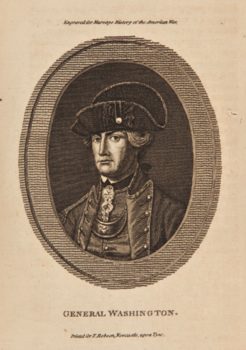
Library of Congress, Baker No. 56/ Hart No. 742
Picture Provided from R.J. Silverstein’s Library
Robert Pollard’s engraving depicts General George Washington, head-and-shoulders portrait, facing slightly left, wearing his uniform, Gorget (An officer’s Badge of Rank), and Cocked hat with a cockade and button; in an oval border made to look like brick. Under the portrait is the title “General Washington”, a bit further down is the legend; Printed for T. Robson Newcastle-upon Tyne. At the top of the page is the legend, Engraved for Murray’s History of the American War. Although the work is not signed, it is the work of Engraver Robert Pollard, of Newcastle Upon-Tyne, where the book was published. He was commissioned for the work and there are numerous signed plates in the work in his style and using similar borders that it leaves no doubt. There are two several impressions and states of this engraving, the great cataloger Joseph Sabin himself had trouble sorting them out as the book was published in segments 1778-1782, and can only be dated by title page and author’s dedication, which changed dates, but not another single word from edition to edition. The first is from Vol 1 of Rev. James Murray’s, “An Impartial History of the Present War in America”, published in 1778, and the 2nd impression, published in James Murray’s, “An Impartial History of the Present War in America, 1779. Thus, the earliest engraving which would have been available to use as the model for the Pater Patria buttons dates to sometime in the year 1
General Washington: Print shows George Washington, head-and-shoulders portrait, facing slightly left, wearing uniform and hat; in oval.
Created / Published: Newcastle, upon Tyne: Printed for T. Robson, [1780]
– Engraved for Murrays History of the American War.
– Illus. in: An impartial history of the present war in America; containing an account of its rise and progress, the political springs thereof, with its various successes and disappointments on both sides / By the Rev. James Murray. Newcastle upon Tyne: Printed for T. Robson [etc., 1778-80], v. 1, p. 239.
– Baker, 56 / Hart, 742
– Published in: The American Revolution in drawings and prints; a checklist of 1765-1790 graphics in the Library of Congress / Compiled by Donald H. Cresswell, with a foreword by Sinclair H. Hitchings. Washington : [For sale by the Supt. of Docs., U.S. Govt. Print. Off.], 1975, no. 214.
Medium: 1 print: engraving and etching.
Call Number/Physical Location: Illus. in E208 .M98 [Rare Book RR] PGA – Robson–General Washington Another impression. (A size)
Repository: Library of Congress Rare Book and Special Collections Division Washington, D.C. 20540 USA Library of Congress Prints and Photographs Division 778.
Of possible interest to Washingtonia collectors, is an item I found during research which indicates that George Washington or one of his family members owned a print of this engraving identified as Baker No. 56, Reference following;
” src=”blob:http://www.georgewashingtoninauguralbuttons.com/b75a763e-4cee-41a3-a1d9-bfbfe2eb5a86″ alt=”image004.png” class=”Apple-web-attachment Singleton” style=”width: 6.5in; height: 2.2333in; opacity: 1;”>
So now to the points of comparison between the likeness of Washington on the Robert Pollard Engraving and the Pater Patria:
The image appears to have been hand-drawn and not traced, as the aspect ratio, and the perspective of the Pater Patriae differ to some degree which indicates that the artist used the engraving as a guide but did the work free hand and not to scale. This indicates that the person who made the buttons had some artistic skill. The similarities will not be exact in every respect, but close enough in many points to determine that this was the model used for the likeness.
Following is figure 1, depicting the Pollard Engraving and the Pater Patria Button: Points of Similarity: 1. Cocked hat, 2. Cockade on the hat with four points to the bow, a button in center, and a strap up to the brim of the hat 3. Fold in the hat is a match 4. Hair style matches 5. Sharply pointed lapels with four button-hole in each lapel 6. He is wearing a Gorget (Badge of rank), shape and size are a match
” src=”blob:http://www.georgewashingtoninauguralbuttons.com/2c5b3342-482f-4a68-af88-1d7b6b2c4fbc” alt=”image006.jpg” v:shapes=”Picture_x0020_13″ class=”Apple-web-attachment Singleton” style=”width: 7.35in; height: 3.7416in; opacity: 1;”>
FIGURE 1, Points of Comparison Between the Robert Pollard Engraving and the Likeness used on the Pater Patriae Buttons
Following is figure 2, depicting the Pollard Engraving and the Pater Patria Button: Points of Similarity: 7. Styling of the cocked hat is quite unique and matches in all point overall 8. The sharp V shaped brow providing a fierce countenance is a match between the likenesses, and was one of the features which might have prompted Washington to remark that the face on the engraving gifted by Colonel Reed, “bore sufficient terror” 9. The single epaulet in the same relative position upon both images is a match.
FIGURE 2, Points of Comparison Between the Robert Pollard Engraving and the Likeness used on the Pater Patriae Buttons
” src=”blob:http://www.georgewashingtoninauguralbuttons.com/4909a25c-659e-415f-836a-31dc5d094b29″ alt=”image008.jpg” v:shapes=”Picture_x0020_12″ class=”Apple-web-attachment Singleton” style=”width: 7.1333in; height: 3.75in; opacity: 1;”>
” src=”blob:http://www.georgewashingtoninauguralbuttons.com/97c234df-8a93-4344-9e84-12fe66947576″ alt=”image010.jpg” v:shapes=”Picture_x0020_11″ class=”Apple-web-attachment Singleton” style=”width: 6.575in; height: 3.4166in; opacity: 1;”>
FIGURE 3, Points of Comparison Between the Robert Pollard Engraving and the Likeness used on the Pater Patriae Buttons: 10. The line of the lips, pout, under the lips and angle of the jaw are unique points of reference for comparison
” src=”blob:http://www.georgewashingtoninauguralbuttons.com/dbb837d1-faf9-4d41-82b7-904156b29bf2″ alt=”image011.jpg” class=”Apple-web-attachment Singleton” style=”width: 2.35in; height: 3.325in; opacity: 1;”>
The “Pater Patriae” Gen.Washington Engraving
MODERN LISTINGS
THE LIBRARY OF CONGRESS
The Library of Congress holds one of these engravings in its collections, the engraving was published in the LOC Publication, pg. 66, The American Revolution in Drawings and Prints; a Checklist of 1765-1790 graphics in the Library of Congress / Compiled by Donald H. Cresswell, with a foreword by Sinclair H. Hitchings. Washington: [For sale by the Supt. of Docs., U.S. Govt. Print. Off.], 1975, no. 683.
The LOC publication lists the engraving as No. 214, pg.66, and states that there are two impressions of this engraving. One published 1780, in James Murray’s, “An Impartial History of the War in America”, and the 2nd impression, published in James Murray’s, “An Impartial History of the Present War in America, 1782.
Title: General Washington
Summary: Print shows George Washington, head-and-shoulders portrait, facing slightly left, wearing uniform and hat; in oval.
Created / Published: Newcastle, upon Tyne : Printed for T. Robson, [1780]
Notes: Engraved for Murrays History of the American War. Illus. in: An impartial history of the present war in America; containing an account of its rise and progress, the political springs thereof, with its various successes and disappointments on both sides / By the Rev. James Murray. Newcastle upon Tyne: Printed for T. Robson [etc., 1778-80], v. 1, p. 239.
– Baker, 56
– Hart, 742
Repository: Library of Congress Rare Book and Special Collections Division Washington, D.C. 20540 USA Library of Congress Prints and Photographs Division Washington, D.C. 20540 USA
———————————————————————
The Metropolitan Museum of Art, credits Engraver Robert Pollard of Newcastle-upon-Tyne as the artist of the General Washington engraving. The engraving is unsigned,; however numerous engravings in Murray’s history executed in the same style with the similar borders employed, make it clear , that this engraving was executed by Robert Pollard. (Note by Robert L. Milburn)
The Metropolitan Museum of Art has one the the Washington engravings among its holdings: An Impartial History of the Present War in American…Vols. I-III, published in parts (1778-1780)
Author: Reverend James Murray (British, 1732–1782)
Engraver: Robert Pollard (British, Newcastle-upon-Tyne 1755–1838 London)
Publisher: T. Robson (Newcastle-upon-Tyne)
Sitter: George Washington (American, 1732–1799)
Medium: Illustrations: engraving
Dimensions:8 7/16 x 5 1/8 in. (21.5 x 13 cm)
Credit Line: Bequest of Charles Allen Munn, 1924
Accession Number:24.90.1831(1-3)
————————————————————————————————————-
Matyas, Stephen M.; Jr., Title: DECLARATION OF INDEPENDENCE A Checklist
Pub: VA Stephen M. Matyas; Jr. 2009, ISBN Number: 0615293131 / 9780615293134
A checklist of books, pamphlets, and periodicals, printing the U. S. Declaration of Independence, 1776-1825. With an appendix of American newspapers printing the Declaration of Independence
Note: This book contains the most informative and thorough information regarding James Murray’s Histories of American published 1780, 1782 of any reference extant. He researched the Murray histories due to the publication of “the Declaration of Independence” included in the work. His notes on the Murray Histories span eight typewritten pages in his checklist, pp 103-109. He specifically addressed the engravings as a whole, and he state that Joseph (sic) [actually Robert] Pollard especially engraved the plates for the work and that the Histories are esteemed for the fine portraits and goes on to say, “Some of these are the first of general notable American to be engraved”. (Comment by Robert L. Milburn)
————————————————————————————————————
Listed in the BOGGLEWOOD On-line Catalog (See Note following) as Number 2813; Hart -742
Artist: UNKNOW, after “Alexander Campbell”, (1775)
Line engraving, 1782, Height 13.5, oval height 8.4, oval width 6.0 cm (Hart)
Note: The BOGLEWOOD CATALOG. This catalog records the images of George Washington that were published before his death on 14 December 1799. Each print is assigned a unique catalog number. Where available, an illustration of the print is included, together with identification of the source upon which its image of Washington is based.
————————————————————————————————————-
Fruance Tavern Museum – Holds one these Portraits in its collections
Catalog Number: 1988.08.005
Title: General Washington, Object: Plate, Engraving, Date: 1782, Artist: Unknown
Description: Line engraving 3/4 view portrait of a young George Washington. Washington in uniform. Portrait inside oval’ ‘frame’, with text above and below the image. ” Engraved for Murray’s History of the American War. / General Washington. / Printed for T. Robson, Newcastle, upon Tyne.”
Dimensions H-8 L-4.75 inches, Collection: Fruance Tavern Museum
————————————————————————————————————-
HISTORIC LISTINGS
DEFINITIVE LISTING – BAKER, William S. Baker, Baker listing numbers are used in concert with Hart numbers to identify important engraving, prints, and images of George Washington.
1880 – (Baker -56) The Engraved Portraits of Washington: With Notices of the Originals and Brief Biographical Sketches of the Painters, William Spohn Baker, Lindsay & Baker, 1880
| ” src=”blob:http://www.georgewashingtoninauguralbuttons.com/99fc4d0f-b7dc-4298-af74-e62839c51ed6″ alt=”image013.jpg” v:shapes=”Picture_x0020_10″ class=”Apple-web-attachment Singleton” style=”width: 6.5in; height: 2.6083in; opacity: 1;”> |
(R.L. Milburn’s note: This portrait is after Artist Alexander Campbell’s 1775 work)
————————————————————————————————————-
| ” src=”blob:http://www.georgewashingtoninauguralbuttons.com/c1675ce1-8ede-4228-bce4-39066dd9804e” alt=”image015.jpg” v:shapes=”Picture_x0020_9″ class=”Apple-web-attachment Singleton” style=”width: 6.5in; height: 0.5416in; opacity: 1;”> |
1895 – Catalogue No. 738, The Great Catalog Sale of Autograph Letters, Historical Documents and Rare Engraved Portraits: Being the Collection of J. Henry Rogers, of Newcastle, Del., By Stan V. Henkels (firm), Bicking Print., pg. 146
| ” src=”blob:http://www.georgewashingtoninauguralbuttons.com/58c4b753-1684-4a50-b912-c30e146fd8ef” alt=”image017.jpg” v:shapes=”Picture_x0020_8″ class=”Apple-web-attachment Singleton” style=”width: 6.5in; height: 0.575in; opacity: 1;”> |
1902 – Auction Catalog No. 94, Of an Interesting Collection of Books, by John Anderson, New York, pg. 14.
| ” src=”blob:http://www.georgewashingtoninauguralbuttons.com/c00369db-94d4-423e-bfe1-f38c8bbb775d” alt=”image020.png” v:shapes=”Picture_x0020_7 Picture_x0020_6″ class=”Apple-web-attachment Singleton” style=”width: 6.5in; height: 1.9666in; opacity: 1;”> |
1903 – The Hampton L. Carson Collection of Engraved Portraits, Issue 906, Parts 1-2, By Hampton Lawrence Carson
————————————————————————————————————-
DEFINITIVE LISTING – HART, Charles H. Hart, HART listing Numbers are used in concert with Baker numbers to identify important Historical engravings/ images
1904 – HART, CHARLES HENRY; Catalogue of the Engraved Portraits of Washington, Pub; NY, Grolier Club
Artist: UNKNOWN,
No. 742 – Bust, to left, in uniform and cocked hat, with gorget and one epaulet. Oval, with border, 8/16, to represent brick-work. Line
ENGRAVED FOR MURRAYS HISTORY OF THE AMERICAN WAR. / GENERAL WASHINGTON. / PRINTED FOR T. ROBSON, NEWCASTLE UPON TYNE. / (Baker – 56)
Height, 5.5. Oval height, 3.5. Oval width, 2.6.
[Murray’s History of the American War. London, 1782.]
————————————————————————————————————-
1904 – Auction Catalog – The Hampton L. Carson collection of engraved portraits of Gen. George Washington, Author: Stan. V. Henkels (Firm), Pub: Philadelphia: Press of W.F. Fell Co.
| ” src=”blob:http://www.georgewashingtoninauguralbuttons.com/6cfc360a-d298-4b58-ad50-024ab2d6d97b” alt=”image022.jpg” v:shapes=”Picture_x0020_5″ class=”Apple-web-attachment Singleton” style=”width: 6.5in; height: 2.35in; opacity: 1;”> |
————————————————————————————————————-
| ” src=”blob:http://www.georgewashingtoninauguralbuttons.com/56f39336-8ec6-4426-9bff-1848a5239d98″ alt=”image024.jpg” v:shapes=”Picture_x0020_4″ class=”Apple-web-attachment Singleton” style=”width: 6.5in; height: 1.3416in; opacity: 1;”> |
1909 – The important collection of engraved portraits of Washington belonging to the late Henry Whelen, jr., of Philadelphia from whose collection, the late Wm. S. Baker, compiled his celebrated book on the “Engraved portraits of Washington” and including all but a few of the portraits mentioned in that work, to be sold … April 27, 1909, by Stan V. Henkels (firm), New York
————————————————————————————————————-
| ” src=”blob:http://www.georgewashingtoninauguralbuttons.com/fc0fdcd1-2097-4041-953e-e5ff915cf1e1″ alt=”image026.jpg” v:shapes=”Picture_x0020_3″ class=”Apple-web-attachment Singleton” style=”width: 6.5in; height: 1.2833in; opacity: 1;”> |
1910 – Catalogue of the Very Important Collection of Rare Americana and Fine Engravings Formed by the Late Edwin Babcock Holden: To be Sold April 21, 1910 at the American Art Galleries, Edwin Babcock Holden, T. E. Kirby, 1910
XXXXXXXXXXXXXXXXXXXXXXXXXXXXXXXXXXXXXXXXXXXXXXXXXXXXXXXXXXXXXXXXXXXXXXXXXXXXXXXX
At the top of the page is the legend, Engraved for Murray’s History of the American War. Although the work is not signed, it is the work of Engraver Robert Pollard, of Newcastle Upon-Tyne, where the book was published. He was commissioned for the work and there are numerous signed plates in the work in his style and using similar borders that it leaves no doubt. There are two impressions of this engraving the first is from Vol 1 of Rev. James Murray’s, “An Impartial History of the War in America”, published in 1780, and the 2nd impression, published in James Murray’s, “An Impartial History of the Present War in America, 1782. Thus, the TPQ for the Pater Patria buttons is 1780.
The engraving was published in the LOC Publication, pg. 66, The American Revolution in Drawings and Prints; a Checklist of 1765-1790 graphics in the Library of Congress / Compiled by Donald H. Cresswell, with a foreword by Sinclair H. Hitchings. Washington: [For sale by the Supt. of Docs., U.S. Govt. Print. Off.], 1975, no. 683.
The LOC publication lists the engraving as No. 214, pg.66, and states that there are two impressions of this engraving. One published 1780, in James Murray’s, “An Impartial History of the War in America”, and the 2nd impression, published in James Murray’s, “An Impartial History of the Present War in America, 1782.
Title: General Washington
Summary: Print shows George Washington, head-and-shoulders portrait, facing slightly left, wearing uniform and hat; in oval. Created / Published: Newcastle, upon Tyne: Printed for T. Robson, [1780]
Notes: Engraved for Murrays History of the American War. Illus. in: An impartial history of the present war in America; containing an account of its rise and progress, the political springs thereof, with its various successes and disappointments on both sides / By the Rev. James Murray. Newcastle upon Tyne: Printed for T. Robson [etc., 1778-80], v. 1, p. 239. – Baker, 56 – Hart, 742
Repository: Library of Congress Rare Book and Special Collections Division Washington, D.C. 20540 USA Library of Congress Prints and Photographs Division Washington, D.C. 20540 USA
For a decade in London, Pollard produced a large number of plates, executed in his own mixed style, composed of line engraving, etching, and aquatint. Some were from his own designs: Lieutenant Moody rescuing a Prisoner, 1785, Adventure of Lady Harriet Ackland, 1784, Edwin and Angelina, 1785, The Blind Beggar of Bethnal Green, and eight plates of shipping.[5]
After other artists, Pollard engraved:[5]
************* ************ ************
 ************
************
This is the earliest application of this specific epithet to Washington. It occurred in a German Almanac, the “Nord Americanische Calendar” for the year 1779, printed in Lancaster, PA. The frontispiece of the full size of the page,sm.410, an emblematic design, presents in the upper right portion of it, a figure of fame with a trumpet in her right hand, and in her left hand a medallion portrait, laureated, inscribed “Washington.” From the trumpet proceed the words, “Des Landes Vater, ” The father of the Country. The material for the almanac, furnished by David Rittenhouse, was doubtless prepared and printed in 1778.- W.S.B.
Meaning, this was the first time George Washington was called, “The Father of the Country.” It was in a German almanac printed in Lancaster, Pa., in 1779. A copy of which is retained in The Library of Congress. The title is, “Der Gantz neue verbesserte Nord Americanische Calender,” auf das 1779, Ste Jahr Christi, Von Anthony Sharp, Lancaster [Pa.], Francis Bailey. It has a portrait of Washington, “Des Landes Vater (Father of the Fatherland) Washington.”
Robert Pollard of Newcastle Tyne, England design was used for the most famous George Washington inaugural button. Due to new evidence researched by Robert Milburn in 2018, we believe this button could have been made as 1780 by using the earliest engraved printing for T. Robinson, but we believe most probable at the war’s end in 1784. Pollard’s engraving was popular among American citizens who supported the Patriot’s Cause. It was common for people to tear his prints out of expensive books so they can hang it on their walls as political propaganda art. The Pater Patriae button was designed to commemorate General Washington as the victorious Commander and Chief over the British in the Revolutionary War. The Pater Patriae button shows high end German construction which is similar to other high end buttons which were made for the gentry or military officers. Masonic Social clubs would often where Revolutionary type buttons such as, the Rattlesnake patterns to make social and political statements. The Pater Patriae Tribute button to Washington would have been the next progressional step in 1784, followed then by inaugural celebratory buttons in 1789.
Strictly by evidence we can tightly date the Pater Patriae to either during or immediately after the revolution in 1780-84. Meaning, this would elevate this button’s historic dynamics to being the 1st American celebratory item. These buttons were most likely marketed to the gentry class to reflect their social and political support for Washington. There is some circumstantial evidence Pater Patriae’s were manufactured in Boston, Massachusetts.
The best way to tighten up the date of manufacture was to establish a A Terminus Post Quem (Limit after which), or the earliest time the event may have happened. Archeologist use the initials TPQ when talking about and dating layers, artifacts and the like. So, in order to firm up the date of manufacture, we thought the best way would be to discover if there was a “Portrait Model” for the design of the buttons and the likeness of “General Washington”.
Our research started by looking for the most identifiable feature of the Pater Patria design, a young Washington in a Cocked hat. At first we looked at Alexander Campbell’s 1775 Engraving of George Washington, and felt that there were some similarities, but not enough for a conclusive match. Afterward, we found and reviewed all the known works of George Washington which were derived from the Alexander Campbell work. This prompted us to find a print portrait engraving in the Library of Congress. Bingo!
We found the engraving which gives an exact match to the Patter Patria’s military bust of General George Washington. This was the same head-and-shoulders portrait, facing slightly left, wearing uniform, Gorget (An officer’s Badge of Rank), and Cocked hat with a cockade and button; in an oval border made to look like brick. Under the portrait in the title “General Washington”, a bit further down is the legend; Printed for T. Robson Newcastle-upon Tyne.
At the top of the page is the legend, Engraved for Murray’s History of the American War. Although the work is not signed, it is the work of Engraver Robert Pollard, of Newcastle Upon-Tyne, where the book was published. He was commissioned for the work and there are numerous signed plates in the work in his style and using similar borders that it leaves no doubt. There are two impressions of this engraving the first is from Vol 1 of Rev. James Murray’s, “An Impartial History of the War in America”, published in 1780, and the 2nd impression, published in James Murray’s, “An Impartial History of the Present War in America, 1782. Thus, the TPQ for the Pater Patria buttons is 1780.
The engraving was published in the LOC Publication, pg. 66, The American Revolution in Drawings and Prints; a Checklist of 1765-1790 graphics in the Library of Congress / Compiled by Donald H. Cresswell, with a foreword by Sinclair H. Hitchings. Washington: [For sale by the Supt. of Docs., U.S. Govt. Print. Off.], 1975, no. 683.
The LOC publication lists the engraving as No. 214, pg.66, and states that there are two impressions of this engraving. One published 1780, in James Murray’s, “An Impartial History of the War in America”, and the 2nd impression, published in James Murray’s, “An Impartial History of the Present War in America, 1782.
Title: General Washington
Summary: Print shows George Washington, head-and-shoulders portrait, facing slightly left, wearing uniform and hat; in oval. Created / Published: Newcastle, upon Tyne: Printed for T. Robson, [1780]
Notes: Engraved for Murrays History of the American War. Illus. in: An impartial history of the present war in America; containing an account of its rise and progress, the political springs thereof, with its various successes and disappointments on both sides / By the Rev. James Murray. Newcastle upon Tyne: Printed for T. Robson [etc., 1778-80], v. 1, p. 239. – Baker, 56 – Hart, 742
Repository: Library of Congress Rare Book and Special Collections Division Washington, D.C. 20540 USA Library of Congress Prints and Photographs Division Washington, D.C. 20540 USA
The “Pater Patriae” General Washington Engraving: THE LIBRARY OF CONGRESS
The Library of Congress holds one of these engravings in its collections, the engraving was published in the LOC Publication, pg. 66, The American Revolution in Drawings and Prints; a Checklist of 1765-1790 graphics in the Library of Congress / Compiled by Donald H. Cresswell, with a foreword by Sinclair H. Hitchings. Washington.
*
************* ************* *************
************* Copper Shell Button Video *************
Emily’s
Repousse Basic’s Demo
Click Here for Low Relief Metal Forming Video
****************
Supportive References for Pater:
The LOC publication lists the engraving as No. 214, pg.66, and states that there are two impressions of this engraving. One published 1780, in James Murray’s, “An Impartial History of the War in America”, and the 2ndimpression, published in James Murray’s, “An Impartial History of the Present War in America, 1782.
Title: General Washington
Summary: Print shows George Washington, head-and-shoulders portrait, facing slightly left, wearing uniform and hat; in oval.
Created / Published: Newcastle, upon Tyne : Printed for T. Robson, [1780]
Notes: Engraved for Murrays History of the American War. Illus. in: An impartial history of the present war in America; containing an account of its rise and progress, the political springs thereof, with its various successes and disappointments on both sides / By the Rev. James Murray. Newcastle upon Tyne: Printed for T. Robson [etc., 1778-80], v. 1, p. 239.
– Baker, 56
– Hart, 742
Repository: Library of Congress Rare Book and Special Collections Division Washington, D.C. 20540 USA Library of Congress Prints and Photographs Division Washington, D.C. 20540 USA
———————————————————————
The Metropolitan Museum of Art, credits Engraver Robert Pollard of Newcastle-upon-Tyne as the artist of the General Washington engraving. The engraving is unsigned,; however numerous engravings in Murray’s history executed in the same style with the similar borders employed, make it clear , that this engraving was executed by Robert Pollard. (Note by Robert L. Milburn)
The Metropolitan Museum of Art has one the the Washington engravings among its holdings: An Impartial History of the Present War in American…Vols. I-III, published in parts (1778-1780)
Author: Reverend James Murray (British, 1732–1782)
Engraver: Robert Pollard (British, Newcastle-upon-Tyne 1755–1838 London)
Publisher: T. Robson (Newcastle-upon-Tyne)
Sitter: George Washington (American, 1732–1799)
Medium: Illustrations: engraving
Dimensions:8 7/16 x 5 1/8 in. (21.5 x 13 cm)
Credit Line: Bequest of Charles Allen Munn, 1924
Accession Number:24.90.1831(1-3)
————————————————————————————————————-
Matyas, Stephen M.; Jr., Title: DECLARATION OF INDEPENDENCE A Checklist
Pub: VA Stephen M. Matyas; Jr. 2009, ISBN Number: 0615293131 / 9780615293134
A checklist of books, pamphlets, and periodicals, printing the U. S. Declaration of Independence, 1776-1825. With an appendix of American newspapers printing the Declaration of Independence
Note: This book contains the most informative and thorough information regarding James Murray’s Histories of American published 1780, 1782 of any reference extant. He researched the Murray histories due to the publication of “the Declaration of Independence” included in the work. His notes on the Murray Histories span eight typewritten pages in his checklist, pp 103-109. He specifically addressed the engravings as a whole, and he state that Joseph (sic) [actually Robert] Pollard especially engraved the plates for the work and that the Histories are esteemed for the fine portraits and goes on to say, “Some of these are the first of general notable American to be engraved”. (Comment by Robert L. Milburn)
————————————————————————————————————
Listed in the BOGGLEWOOD On-line Catalog (See Note following) as Number 2813; Hart -742
Artist: UNKNOW, after “Alexander Campbell”, (1775)
Line engraving, 1782, Height 13.5, oval height 8.4, oval width 6.0 cm (Hart)
Note: The BOGLEWOOD CATALOG. This catalog records the images of George Washington that were published before his death on 14 December 1799. Each print is assigned a unique catalog number. Where available, an illustration of the print is included, together with identification of the source upon which its image of Washington is based.
————————————————————————————————————-
Fruance Tavern Museum – Holds one these Portraits in its collections
Catalog Number: 1988.08.005
Title: General Washington, Object: Plate, Engraving, Date: 1782, Artist: Unknown
Description: Line engraving 3/4 view portrait of a young George Washington. Washington in uniform. Portrait inside oval’ ‘frame’, with text above and below the image. ” Engraved for Murray’s History of the American War. / General Washington. / Printed for T. Robson, Newcastle, upon Tyne.”
Dimensions H-8 L-4.75 inches, Collection: Fruance Tavern Museum
————————————————————————————————————-
HISTORIC LISTINGS
DEFINITIVE LISTING – BAKER, William S. Baker, Baker listing numbers are used in concert with Hart numbers to identify important engraving, prints, and images of George Washington.
1880 – (Baker -56) The Engraved Portraits of Washington: With Notices of the Originals and Brief Biographical Sketches of the Painters, William Spohn Baker, Lindsay & Baker, 1880
In the late 18th Century, public curiosity of revolutionary war figures, battles, and events produced a feverish interest for news and a usual demand for prints of Patriot leaders and Revolutionary War heroes. The Patriot’s Cause was not just limited to American newspapers in the British Colonies, but information was circular in nature of dated events to help provide pressure for English and European Jacobite sympathizers. Journalist would feed the Patriots Cause with the Liberty & Independence themes of social contract activists who kept public political sentiment at a feverish pitch. A common practice was to remove certain Revolutionary War Hero’s prints from newspapers, or expensive books and display them on the walls in their homes. This war time event in America caused a frenzy of personal interest across the Atlantic by both Loyalists or sympathetic Jacobite European activists who fed the news media.
Replica Pewter Pater Patriae Buttons

In 2019, Dale had brought to my attention that a “club” had a mold made of the Pater Patriae button and fabricated Pewter buttons for its members. The button was most likely made for members of a Revolutionary War re-enactors club, and not made for purposeful intent of duping button collectors. We thought it would be important to note this for future button collectors to clearly understand that this Pewter replica is a modern 21st century replica button. Since, original Pater Patriae’s are significant to America’s history during the Revolutionary War Period they carry a market premium. To be clear, there would never have been a Pewter Pater button made by German-American Artisans in the 18th century.
